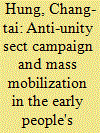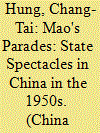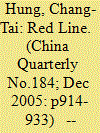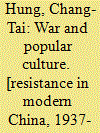|
|
|
Sort Order |
|
|
|
Items / Page
|
|
|
|
|
|
|
| Srl | Item |
| 1 |
ID:
096595


|
|
|
|
|
| Publication |
2010.
|
| Summary/Abstract |
The anti-Unity Sect campaign (1949-53), a precursor to the Campaign to Suppress Counterrevolutionaries (the zhenfan movement), was one of the Chinese Communists' most violent policies to root out a perceived evil cult in China. This article argues that the drive was never simply a religious crusade. It was essentially a mass mobilization for the purpose of consolidating the Communists' power and legitimacy. Through a host of propaganda channels, including media attacks and public trials, the Communists dealt a crippling blow to the sect. The mobilization campaign turned many citizens into supporters and agents of the government, and its tactics would soon be mimicked in subsequent political movements.
|
|
|
|
|
|
|
|
|
|
|
|
|
|
|
|
| 2 |
ID:
161518


|
|
|
|
|
| Summary/Abstract |
In recent years, five historic Chinese Communist revolutionary sites—Shanghai, Jinggangshan (Jiangxi province), Zunyi (Guizhou province), Yan’an (Shaanxi province) and Xibaibo (Hebei province)—have been labeled as the most sacred sites in the history of the Chinese Communist Party (CCP) by local officials in order to promote tourism and patriotic education among young people. This widely publicized state campaign has been undertaken in an era of reform driven by unbridled capitalistic market forces when Communist ideology is losing its magnetic pull. However, the official promotion of these old revolutionary sites reveals several sharp areas of tension in today’s China: ‘red tourism’ (exploiting the heritage of the CCP for the tourism industry) versus ‘green tourism’ (scenic sightseeing for personal gratification), Communist ideology versus a market economy, and state domination versus local autonomy.
|
|
|
|
|
|
|
|
|
|
|
|
|
|
|
|
| 3 |
ID:
078684


|
|
|
|
|
| Publication |
2007.
|
| Summary/Abstract |
Political parades in the People's Republic of China are a rich and complex cultural text from which historians can gain a deeper understanding of the nature and policies of the Chinese Communist Party (CCP). The CCP's state spectacles, primarily the parades during the May Day and National Day (1 October) celebrations held in Tiananmen Square in the 1950s, were a well-organized political ritual with multiple purposes: festivals of iconoclasm, demolishing the old order and embracing the new era of socialism; a legitimation of the CCP's authority; a display of myriad achievements under communism; an affirmation of the centrality of Mao's role in modern Chinese revolutionary history; and an announcement of China's presence in the international socialist camp. The parades, although influenced by the Soviet Union, exhibited strong native colours. They also reflected a nation undergoing political and economic changes. In the end, Mao Zedong and his senior Party leaders, acting both as actors and directors, carefully controlled and choreographed the paraders, who were themselves the audience, in Tiananmen Square to heap praise on the achievements of the Party and its chairman
|
|
|
|
|
|
|
|
|
|
|
|
|
|
|
|
| 4 |
ID:
067962


|
|
|
| 5 |
ID:
133812


|
|
|
|
|
| Publication |
2014.
|
| Summary/Abstract |
To win the hearts and minds of the Chinese people, Chinese Communist leaders launched a series of educational reforms to instill new socialist ideas and nationalistic fervor in kindergarteners immediately after the founding of the People's Republic of China in 1949. Under the strong influence of Soviet advisers and through a number of methods (games, singing, storytelling, site visits), Chinese kindergarteners were taught the nobility of labor, the sacrifice of soldiers, the grandeur of Tiananmen Square, the wise leadership of Chairman Mao Zedong, and the evilness of enemies. However, contrary to the conventional view, this article argues that Chinese education officials and kindergarten teachers never blindly followed Soviet educational models. They appropriated Moscow's techniques to suit their domestic needs, which included promoting nationalist feelings among children to consolidate the Chinese Communist Party's legitimacy and power. Ultimately, Chinese kindergarteners were turned into Party loyalists, not admirers of a foreign socialist model. Although the Party encountered difficulties in recruiting reliable teachers to implement its policies, it was able to impose nearly total control from above over the political content of kindergarten education. Under the one-party system, Chinese children were only taught what the Communist leaders wanted them to learn.
|
|
|
|
|
|
|
|
|
|
|
|
|
|
|
|
| 6 |
ID:
048582


|
|
|
|
|
| Publication |
Berkeley, University of California Press, 1994.
|
| Description |
xv, 432p.
|
| Standard Number |
0520082362
|
|
|
|
|
|
|
|
|
|
|
|
Copies: C:1/I:0,R:0,Q:0
Circulation
| Accession# | Call# | Current Location | Status | Policy | Location |
| 040032 | 306.0951/HUN 040032 | Main | On Shelf | General | |
|
|
|
|
|
|
|
|
|